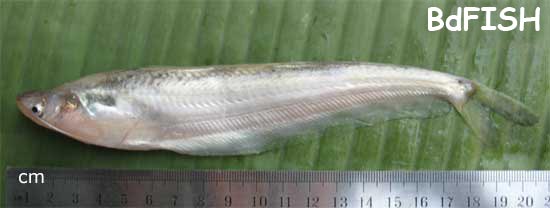
Synonyms:
Silurus canio, duda, chechra Hamilton, 1822
Callichrous bimaculatus Day, 1878
Callichrous bimaculatus Shaw and Shebbeare, 1937
Callichrous bimaculatus Qureshi, 1965
Ompok bimaculatus Munro, 1955
Ompok bimaculatus Bhuiyan, 1964
Ompok bimaculatus Jayaram, 1977
Common name: Butter Catfish
Local name: Kani pabda, boali pabda
Taxonomy position:
Phylum- Chordata
Class-Oesteichthyes
Order- Siluriformes
Family- Siluridae
Genus- Ompok
Fin formula:
D. 4; P1.12-15(1/11-14); P2. 8; A. 66-73. (Rahman, 2005)
D 4; A ii-iii 57-58; P I 12-14; V i 7-8 (Talwar and Jhingran, 1991)
Description of the species:
Elongate body is strongly compressed. Head depressed and snout rounded. Mouth is superior. Lower jaw is longer than upper. Two pairs of barbels are present. Maxillary barbels extend posterior to (or slightly beyond) anal fin base. Nostrils widely separated from each other. Teeth found on jaws and vomer. Caudal fin is deeply forked and its upper lobe long. Dorsal side grey, a transverse blackish spot present, behind the operculum on the lateral line, caudal stripped with black spots; besides, there are purple and yellowish spots throughout the body. Anal fin with 57 or 58 branched rays. (Bhuiyan, 1964; Rahman, 1989; Rahman, 2005; Parween, 2007; Talwar and Jhingran, 1991)
Habit and Habitat:
It is a fresh water fish, extensively in rivers, rivulets, streams, beels, canals, flooded jute fields in the rainy season. It feeds on the rainy season. It feeds on the crustacean larvae, algae, protozoans, a little mud and sand (Bhuiyan, 1964).
Economic importance:
It is great demand and market price on account of its good test, flavour and invigorating effect. This fish has been bred using hormone injections in the aquaculture in the aquaculture station of BFRI, Mymensingh. Farmers culture the species in ponds (Parween, 2007).
Status and Conservation:
This fish is listed as endangered in IUCN Red book of threatened fish of Bangladesh by IUCN Bangladesh (IUCN Bangladesh, 2000). The species can be conserved by providing safe habitats like sanctuaries in suitable sites (Parween, 2007).
.
References:
Day, F. 1878, The Fishes of India: being a Natural History of the Fishes Known to Inhabit the seas and fresh waters of India, Burma and Ceylon. Text and Atlas in 4 parts. William Dawson & Sons Ltd. London, p. 476.
Day, F. 1889. The fauna of British India, including Ceylon and Burma. Fishes. Taylor and Francis, London. vol.1: 548 pp and vol.2: 509 pp.
Hamilton, F. 1822. An account of the fishes found in the river Ganges and its branches, Edinburgh & London, Fishes Ganges, p. 151-152.
IUCN Bangladesh. 2000. Red Book of Threatened Fishes of Bangladesh. IUCN- The World Conservation Union. xii+116 pp.
Jayaram, K.C. 1977. Aid to identification of siluroid fishes of India, Burma, Sri Lanka, Pakistan and Bangladesh. I. Bagridae. Rec. Zool. Surv. India Occ. Paper, (8): 1-41.
Munro, I.S.R. 1955. The marine and fresh water fishes of Ceylon. Dept. of External Affairs, Canberra. 349 pp.
Parween, S. 2007. Ompok bimaculatus (Bloch, 1797). In: Siddiqui, K.U., Islam, M.A., Kabir, S.M.H., Ahmed, M., Ahmed, A.T.A., Rahman, A.K.A., Haque, E.U., Ahmed, Z.U., Begum, Z.N.T., Hasan, M.A., Khondker, M., and Rahman, M.M. (eds.). Encyclopedia of Flora and Fauna of Bangladesh, Vol. 23. Freshwater Fishes. Asiatic Society of Bangladesh, Dhaka. p.127.
Qureshi, M. R. 1965. Common Freshwater Fishes of Pakistan. Karachi VIII. p.31.
Rahman, A.K.A. 2005. Freshwater Fishes of Bangladesh (Second edition). The Zoological Society of Bangladesh, Department of Zoology, University of Dhaka, Dhaka-1000. 394 pp.
Rahman, A.K.A. 1989. Freshwater Fishes of Bangladesh. The Zoological Society of Bangladesh, Department of Zoology, University of Dhaka, Dhaka-1000. p 167.
Shaw and Shebbeare, 1937, The Fishes of Northern Bangal. Journal of Royal Asiatic Society of Bengal Science. p 82.
Talwar, P. K. and Jhingran, A. G., 1991. Inland Fishes of India and Adjacent Countries. Volume 1. Oxford & IBH Publishing Co. Pvt. Ltd. New Delhi, Calcutta. p 582.
Visited 7,413 times, 1 visits today | Have any fisheries relevant question?
